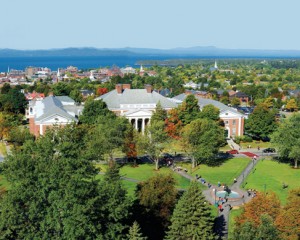How far will $16 million dollars go to create green college campuses in the Green Mountain State? A lot further than you think. Recently, twelve of Vermont’s most prominent institutions of higher education pledged more than $16 million to green revolving funds, and they are using this money to make major improvements in energy efficiency – with an impact far greater than their initial investment.
Green Revolving Funds create campuses to be proud of
Vermont colleges now have the means and opportunity to make campuses energy-efficient, sustainable, and more affordable. Energy efficiency projects funded by the green revolving funds will allow Vermont colleges to lower operating costs and help "green the bottom line," because they enable the institutions to immediately start capitalizing on the savings produced by energy efficiency projects. The best part is that as funds are invested in projects, they are repaid by the savings realized through reductions in energy usage. This means that institutions can recycle their dollars indefinitely, and ensure that they always have a ready source of capital to pay for new projects and make long term investments in energy efficiency.
Beyond energy savings: The benefits of green revolving funds
- Efficiency is a Smart Investment. We know that investing in energy efficiency is the right thing to do for the planet – but increasingly institutions are realizing that it helps their bottom line. In a recent survey of college and university green revolving funds, performed by the Sustainable Endowments Institute, established funds reported a median return on investment of 32 percent. They also provide an ongoing, reliable source of capital to support projects that reduce operating costs.
- Commitment to Sustainability. Green revolving funds are a tangible, practical, and effective way for colleges and universities to show that their commitment to sustainability goes much deeper than a motto. When they put real money on the table in support of smarter energy choices, they show that they value sustainability on a deep level, and that they have integrated this belief into every aspect of their operations. Increasingly, this is a message that faculty, staff, alumni, and prospective students want to hear.
- Catalyzing Campus Engagement. A stated commitment to energy efficiency – especially when coupled with the presence of a reliable funding source to support projects - is a major catalyst for action. But many colleges and universities are taking it a step further than that, by actively engaging with their campus community to solicit input and ideas, as well as to help drive projects to completion. In that respect, green revolving funds are a great way to help build vibrant, thoughtful, and creative learning environments – all while nurturing the next generation of energy efficiency experts.
What’s next for Green Revolving Funds?
As we know,
the potential for energy efficiency is massive. Green revolving funds represent a replicable, market-based approach to support efficiency, which is not limited to institutions of higher education. In Vermont, we are very excited to be at the forefront of this growing energy transformation.
Vermont institutions that have so far committed to establish green revolving funds are: Burlington College, Champlain College, Green Mountain College, Middlebury College, Saint Michael’s College, University of Vermont, Vermont Law School, and the Vermont State Colleges (Castleton State College, Community College of Vermont, Johnson State College, Lyndon State College, and Vermont Technical College).
Jim Merriam is the Director of Efficiency Vermont, a statewide energy efficiency utility helping all Vermonters lower their energy costs.
 University of Vermont is one of 12 higher education institutions in the state investing millions in energy efficiency.
University of Vermont is one of 12 higher education institutions in the state investing millions in energy efficiency.